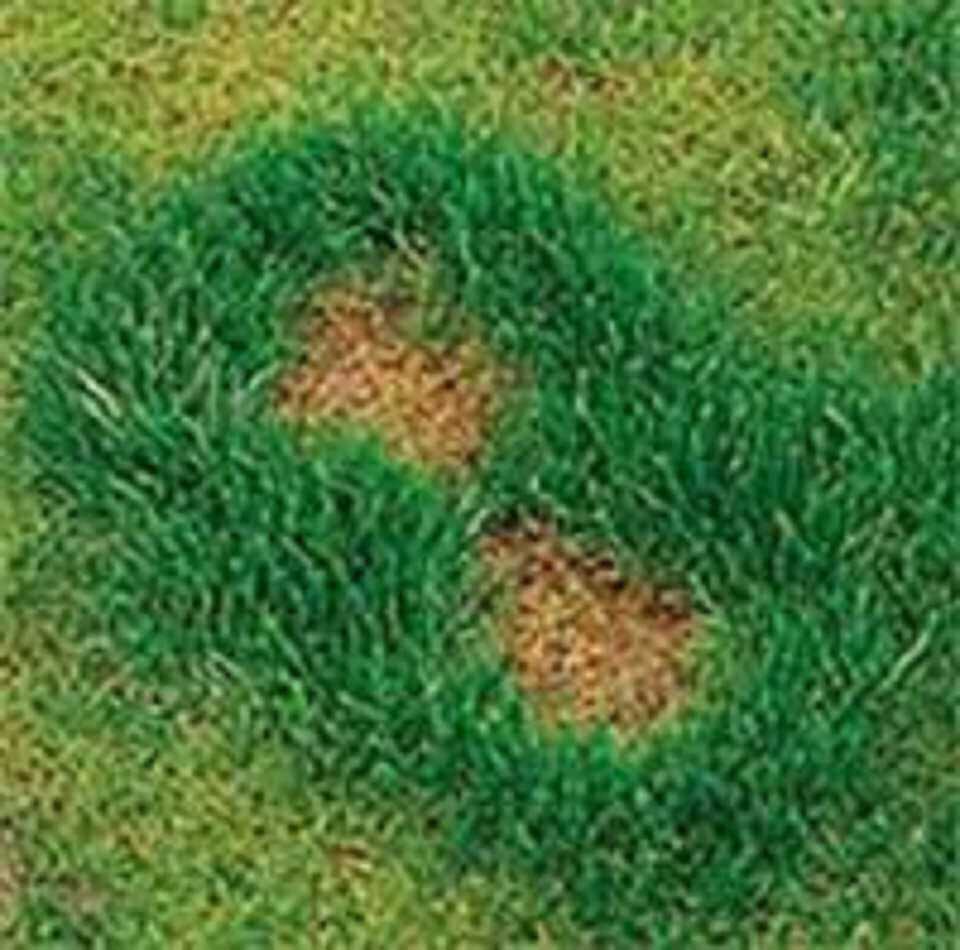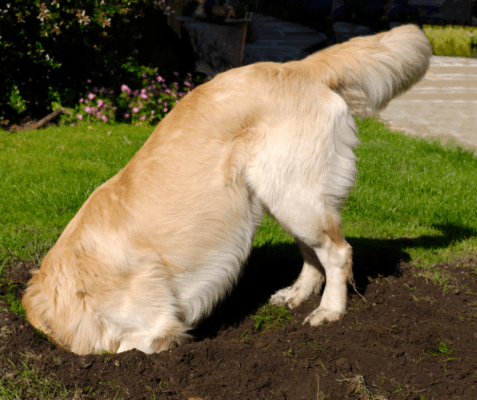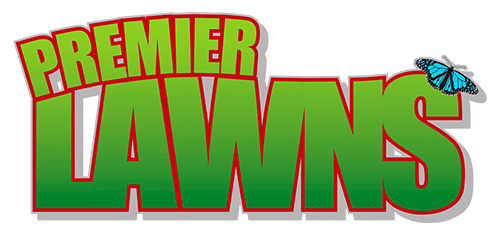This spring, I’ve been answering lots of questions about lawns for dogs. I’ve been hearing from worried dog owners who are concerned that their much loved pets are damaging their lawns. The biggest problem of all seems to be caused by dog pee on the lawn.
In this article I’m looking at how dog pee damages your lawn and what you can do to manage the problem. It’s important to understand at this stage that there is no magic bullet. But there are things that you can do, and some that I can do for you, to reduce the impact your pets have on your lawn.
How to stop dog pee damaging your lawn
I’m sure if you’re reading this that you’re familiar with the effect of pet pee on your lawn. It can sometimes happen even if you don’t have a dog of your own. You may be visited by a fox or a stray dog.

If the damage mild-moderate damage you will see circles of grass that look much greener and grow much faster than the rest of the lawn.
If the damage is more severe, you will typically see scorched brown or straw-coloured circles surrounded by very dark green grass.
How does dog pee damage your lawn?
Dog pee contains a chemical called urea which is excreted by the kidneys. Urea is a compound of nitrogen. Nitrogen is an essential plant nutrient. It makes grass grow faster, stronger and greener. However if it’s present in a very high concentration, it will scorch the grass. It follows then, that very strong pee, will scorch the lawn. Adult boy dogs tend to go around the edge of the garden sprinkling fences and bushes, so their pee doesn’t find its way onto the lawn very often. Girls and puppies though will squat and empty their bladder in one place and that’s where problems arise.
There are two approaches to managing lawns for dogs. One is to restrict access to the lawn. The other is to tweak the dog’s diet in order to reduce the strenght of the pee. I also advocate adapting your lawn maintenance regime to help the plants cope with the challenges.
Image credit www.lawnscience.co.uk
How to prevent lawn damage from dog pee
I’m led to believe that the secret to having a lovely lawn AND a dog, is to either
- discourage the dog from emptying its bladder on the lawn, or
- make sure the wee is dilute enough so that the damage is minimal.
You could, chase your dog round the garden and empty a bucket of water onto the lawn wherever she pees. We both know that’s not really a practical solution. So here are some rather more sensible ideas.
Train the dog to toilet in one place:
In an ideal world your dog would empty its bladder and bowels somewhere that isn’t on the lawn. To achieve this, you could fence off an area of the garden and only let the dog onto the lawn when you are confident that he or she is empty. Alternatively, speak to Vivienne at The Doggy Den NI who can help you to train your dog to pee in one place.
Letting the dog out more often
More frequent visits to the garden will help too. When the bladder is full for a long time, its contents become more concentrated. A frequent pee-er should theoretically cause less damage.
Take your dog for walkies
Ideally, two or three times a day. You’ll become fitter, your dog will really be loving life and your lawn will have a bit of a reprieve too when most of the business gets done elsewhere.
Pick up poos
Clear up as soon as they appear! An essential job on lawns for dogs. If left for a long time, dog poo can damage your lawn. Plus it’s horrible stuff to have to pick out of your mower blades if you accidently run over it!
Talk to your vet
Discuss what your dog is eating. Urea is a by-product of protein. If your dog has more protein in his diet than his body really needs, it will be excreted in his wee. But please please please don’t change your dog’s diet without talking to the vet first. I know very little about canine health and nutrition and I’m certainly not qualified to give advice.
Dog rocks
There is a product on the market called dog rocks. They look exactly like stones that you leave at the bottom of the dog’s water bowl. I’ve seen mixed reviews for them and my dog loving friend, from the turf growing industry is quite cynical about their effectiveness. If you do decide to try them, please let me know how you get on so I can share the information with other dog owners.
Plenty of water
Make sure your dog has access to a constant supply of clean drinking water – the more your dog drinks hey-presto, it dilutes the urea in her pee and makes it less damaging!
Physical damage from dogs

By physical damage I mean soil compaction, heavy wear and tear and even digging holes. From a lawn care perspective these things are relatively easy to repair. But how to stop them recurring? Well, that’s between you and your dog.
If your pet spends a lot of time running around the garden, barking at the fence or digging holes, there’s a good chance he’s either bored, lonely or anxious. You could of course restrict the amount of time he spends unsupervised in the garden. However, that may result in him behaving badly indoors.
Repairing dog damage to a lawn
Mild urine scorch – the sort where you have dark green patches in the lawn – can be disguised by applying an iron-rich supplement to your lawn. What it does it green up the rest of the grass so that the colour is more evenly matched. I recommend regular applications of an organic seaweed feed.
Read more about seaweed feed here
Severely scorched areas may need to be cut out and replaced. It’s important to remove some of the soil as this is where the excess nitrogen will be sitting. Re-seeding onto fresh soil will quickly repair the damage and you’ll never know anything was wrong. However for best results in the long term you really should find a way that works best for your lawn and your dog.
The Premier Lawns way of managing lawns for dogs
As an independant lawn care company, I am able to tailor lawn care regimes to suit each individual lawn. Where dog damage is an issue I can recommend and apply specialist treatments that are only available to greenkeepers.
It’s impossible for me to make firm recommendations without seeing a lawn but in general, if you are having problems with dog pee or any other kind of doggy damage I would strongly suggest the following.
- Book a lawn care consultation to find out which renovations and treatments will help your lawn to reach its full potential
- Consider aerating your lawn 2-3 times a year in order to help dog pee drain away quicker and make the grass plants more robust.
- Talk to your vet to see if your dog’s diet could be partly to blame for the problem.
- Get in touch with a dog behavioural expert who can help you teach your dog a different way of doing things.
Problems with your lawn?
Lawns for dogs pose their own challenges but dogs are not the only thing that could be causing odd coloured patches in your lawn. There are a whole host of lawn pests and diseases that cause discoloured patches. Leatherjackets for example or Redthread disease. If you are at all worried by mysterious blotches and blemishes in your plot, call me, Robbie at Premier Lawns. I’m a trained greenkeeper and have access to all kinds of remedies that you’ll not find in the garden centre.
Read more about Leatherjackets in the lawn
